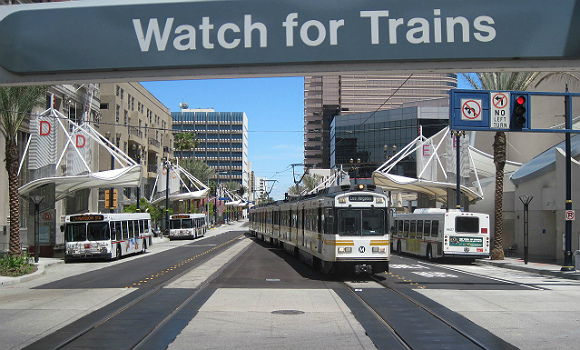
Long Beach transit center. (Photo Credit: Tisoy/Flickr)
When we look back at the year in California’s year in infrastructure news, it’s no surprise to find stories about how the state’s high-speed rail project is finally moving ahead and how water policy is coming to a head.
This year wasn’t much different in those areas, when the biggest drought in some time turned water policy into a top concern among voters, awarded the revamped water bond an advantage at the polls, an provided an important boost to preparation for the next drought.
At the same time, important Summit priorities were realized in the final state budget, including a permanent fund for transit-oriented, affordable housing and transit projects that found its way into the cap-and-trade revenue deal.
For more on the year in California infrastructure news, we talked to Fred Silva, California Forward‘s senior fiscal policy advisor and expert in state and local finance, about another important development this year what it means for 2015:
Last year we talked about how two important infrastructure measures would likely come up for a vote in 2014, the water bond and an improved tool for driving local infrastructure development. Both passed: Proposition 1 and an Enhanced Infrastructure Financing District (EIFD) bill, respectively. How do the final products fit into the Summit’s priorities?
In 2012, the Economic Summit developed a new framework for infrastructure financing that was based on two assumptions. The first was that most of our infrastructure needs differ by regions and second, the financing tools should be flexible enough to account for those differences. The funding included in the water bond (Prop. 1) and the new local infrastructure financing authority contained in the EIFD legislation move in that direction.
What can EIFD’s do to improve infrastructure project results and restore public confidence?
Unlike the old redevelopment law that focused on a specific urban condition (reducing blight) this new authority will allow a community to make choices about a broad range of infrastructure investment including water supply, transportation, affordable housing and other community improvement. It is argued that community involvement in that decision will increase public confidence.
Where have been the suggestions to return to some form of Redevelopment Agencies 2.0?
Last year the Governor vetoed Redevelopment 2.0. As time passes the authorities contained in the EIFD legislation will fill the void left by the elimination of the old redevelopment process.
Not having enough affordable housing obviously hurts local economies. What can EIFD’s do for a city to help tackle the problem?
Building affordable housing is an authorized activity under the EIFD statute. Since the statute includes a broad range of financing authorities (use of the growth in the property tax, benefit assessments and fees) local resources can be used to leverage state dollars particularly cap-and-trade revenue.
Is there growing interest across the state in EIFD’s, since the Governor signed the new EIFD bill? What types of projects are being discussed?
There is a growing interest in the statue. Webinars and conference panel discussions bring the infrastructure finance sector to review the potential. Potential uses include neighborhood improvements, mixed use urban projects and transportation project. Those interested should sign up for a free webinar from Meeting of the Minds on January 13, 2015. Registration is here: http://cityminded.org/cal/infrastructure-financing-tools/
What will likely be the big infrastructure story on 2015?
There will be a broad range of activities as local agencies see the opportunities in the statute.
—————————-
You can find more of our infrastructure coverage and more in our Infrastructure Reporting archives.

